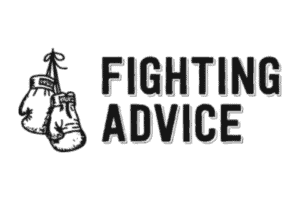It’s no secret that Brazilian Jiu-Jitsu is one of the world’s most physically and mentally demanding martial arts. To train effectively, you need the right gear.
Do you really need a Gi for the first BJJ class? In general, you don’t need a Gi for the first class. However, there are some things that you should bring with you to the first class. You should bring comfortable clothes, a bottle of water, a mouthguard, a towel, and slippers.
The Gi is a necessary part of Brazilian Jiu-Jitsu. It is a type of uniform that is worn during training. The Gi helps to protect the fighter and make holds and submissions more effective. The BJJ Gi is made of a thick fabric that can withstand a lot of wear and tear.
It is essential to choose a Gi that is comfortable and fits well. There are many different types and brands of Gis available on the market, so it is important to do some research before purchasing one.
What Will You Need?
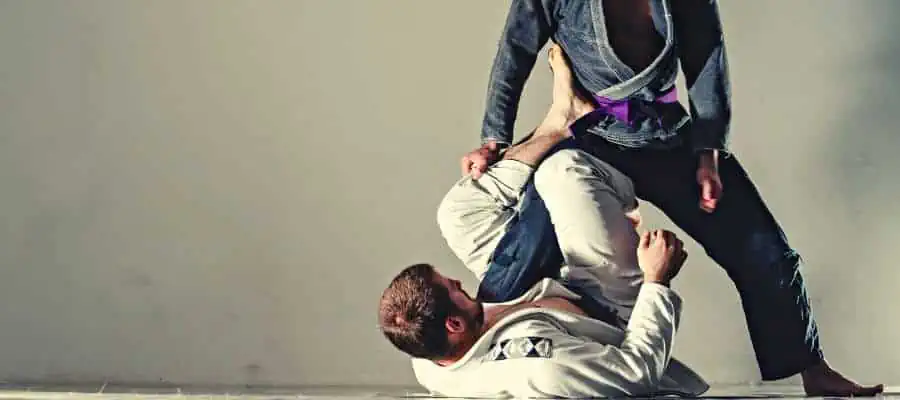
Brazilian Jiu-Jitsu is an incredibly demanding sport, both physically and mentally. To train effectively, you need to be adequately equipped. Here’s what you need to bring with you to your first BJJ class:
Comfortable Clothes
The first thing that you need to bring with you to your first BJJ class is a comfortable set of clothes. You should avoid wearing anything too loose or too tight. Tight clothes can restrict movement and may be uncomfortable to wear for an extended period.
Baggy clothes can make it difficult to move and get in the way when you are trying to apply a hold or submission.
A Rashguard
A rashguard is a type of shirt that many athletes wear. Rashguards are tight-fitting and made of stretchy material. They help to wick away sweat and keep the body cool. Rashguards are not required for the first class, but they are recommended.
A rashguard will help you avoid mat burn and make moving around easier. You can buy a rashguard at most sporting goods stores for about $30. There are many different brands of rashguards on the market. Here are some of the best brands:
- Venum
- Hayabusa
- Tatami
- Gameness
- Affliction
- RVDD
A Pair Of Fight Shorts
Fight shorts are another type of clothing that athletes commonly wear. They are similar to rashguards in that they are tight-fitting and made of stretchy material. Fight shorts are comfortable and allow a full range of motion.
Some fight shorts have double layers. One is tight like a rashguard, while the other is baggy like traditional shorts. Like rashguards, fight shorts are not required for the first class but are recommended. You can find a pair of fight shorts at most sporting goods stores for around $30.
A Bottle Of Water
Next, you will need to bring a water bottle to class. BJJ is extremely physically demanding, and you must stay hydrated throughout the session. It is essential to drink water before, during, and after class. You can buy an isotonic drink to replenish your electrolytes if you sweat much. You can even make your isotonic drink from an isotonic drink powder and water.
A Mouthguard
A mouthguard is a strongly recommended piece of gear for BJJ training. The mouthguard will help to protect your teeth and gums from injury. Choosing a mouthguard that fits well and does not restrict your breathing is crucial.
You can find mouthguards at most sporting goods stores. You might need to get a custom-made mouthguard from your orthodontist if you wear braces. However, there are also special mouthguards designed to be used with braces.
A Towel
Another essential item you should bring to class is a towel. A towel will help you to keep dry and comfortable during training. It is important to choose a towel that is absorbent and quick-drying. If you plan on showering after training, ensure to bring another towel for that as well.
Slippers
Finally, you will need to bring a pair of slippers to class. Slippers are worn inside the academy and help to keep the mats clean. You can find slippers at most sporting goods stores. Try to find a comfortable pair and easy to slip on and off.
You can take an additional pair of slippers (rubber ones) if you plan on showering after class. These protect your feet against the all-so-prevalent fungus people tend to get in “gym showers.”
A Cup (For Men)
A cup is a strongly recommended piece of gear for male BJJ practitioners. The cup will help to protect your groin area from strikes. Choosing a cup that fits well and does not restrict your movement is important. You can find cups at most sporting goods stores.
However, many BJJ practitioners don’t wear a cup since it can be uncomfortable during training.
An Open Mind
In addition to the physical gear you will need for your first BJJ class, it is also essential to bring an open mind. BJJ is a very demanding sport, and it can initially be overwhelming. Do not be discouraged if you do not pick up the techniques quickly. It is important to remember that everyone was a beginner once. With time and practice, you will get better.
BJJ is a great way to get in shape, learn self-defense, and meet new people. It is important to remember that BJJ is a martial art, not a sport. There is no competition in BJJ, at least not at first. The training aims to improve your techniques and become more proficient at the art.
Once you have been training for a while and have perfected the basic techniques, you can begin to spar with more experienced practitioners. You will be matched up as a beginner with other beginners in class. This is to ensure that everyone is training safely and effectively.
Why Don’t I Need A Gi For The First Class?
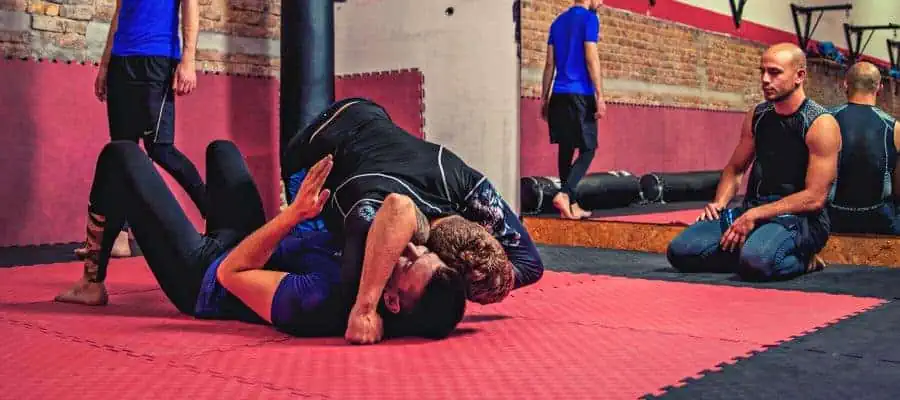
You don’t need a Gi for the first class because you will learn BJJ’s basics. You will learn moves such as how to escape from wrong positions and apply basic submissions. You will also learn the basic warmup movements and stretches. All of these things can be learned without the Gi.
In addition, most academies have a beginner’s class specifically designed for people new to the sport. The instructors usually wear a Gi in these classes to show the students the proper techniques. However, the students are not required to wear a Gi.
A Gi is not necessary for learning these techniques. In addition, wearing a Gi can be uncomfortable for some people, primarily if they are not used to it. Once you have been training for a while and have learned the basics, you can progress to the more advanced classes. These classes will require you to wear a Gi.
Wearing A Gi For The First Time
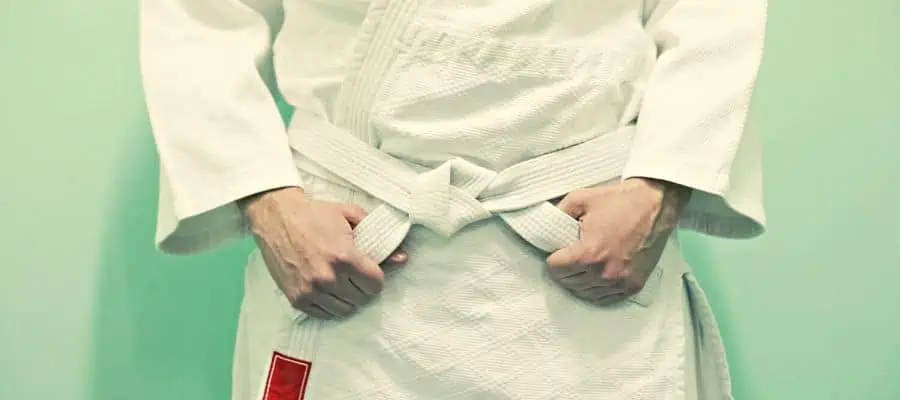
If you decide to wear a Gi for your first class, then there are a few things that you need to keep in mind. First, you need to make sure that your Gi fits well. A Gi that is too loose or tight can be very uncomfortable to wear.
Second, you need to choose a Gi made from a comfortable material. Some Gis are made from cotton, while others are made from synthetic material. Third, you must select a Gi that is the right color. Most academies have a white Gi-only policy. However, some academies do allow students to wear colored Gis.
A Note On Hygiene
It is important to remember that BJJ is a contact sport. This means skin diseases such as ringworm or staph infection are at risk. For this reason, it is crucial to practice good hygiene when training. You should always shower after training and ensure your Gi is clean.
In addition, you should avoid sharing personal items such as towels or water bottles with other people.
How To Prepare For Your First BJJ Class?

Now that you know what to bring to your first BJJ class, you must know how to prepare for the class. First, you need to wear comfortable clothing that you can move around in. Second, if you have long hair, you need to tie your hair back so that it is out of your face.
Third, you must arrive early to sign in and warm up at the academy. Another crucial thing is to clip your nails and toenails so that you do not hurt yourself or your training partners. Finally, you need to listen to the instructor and ask questions if you are unsure about something.
What To Expect In Your First BJJ Class?
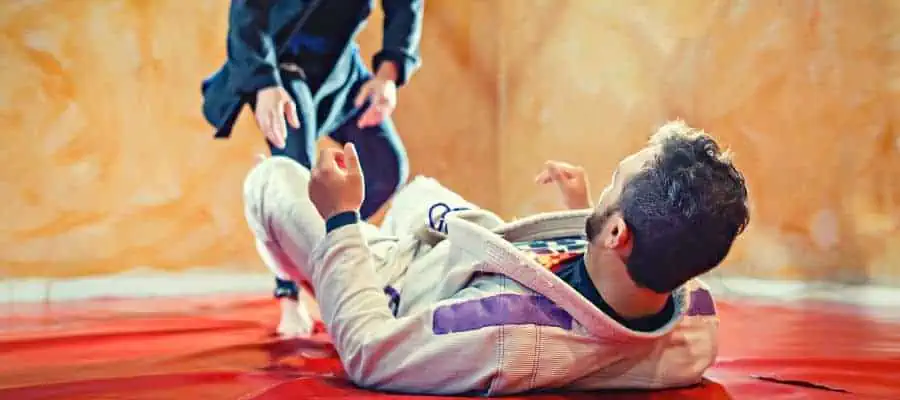
In your first BJJ class, you will be shown the basic warmup movements and stretches. After the warmup, you will be shown how to escape from the wrong positions, such as being on your back. You will also learn how to apply basic submissions such as the chokehold.
In addition, you will be taught the basic rules of BJJ. After the class, you will have the opportunity to spar with a training partner. This is a great way to practice what you have learned in class.
Most schools have sparring (rolling) sessions after the technique portion of the class. This is highly encouraged as it’s the best way to apply what you’ve learned. It’s also a great way to get used to the feeling of being in close contact with someone else wearing a gi.
Sparring Without Experience
You will understand BJJ’s power during your first rolling (sparring) session. It is a demanding sport that requires incredible strength, flexibility, and technique. You will quickly learn that you must be in excellent physical condition to spar effectively.
In addition, you must have good balance and coordination. And finally, you must be able to control your emotions and stay calm under pressure.
As you roll, pay attention to what your opponent is doing and try to learn from it. You will see the skills your opponent has learned throughout his BJJ training. You will also realize the importance of proper technique. BJJ is a very technical sport. Many small details can mean the difference between winning and losing.
They will most likely submit you within the first half minute. It’s happened to everyone. Don’t get discouraged. Just keep rolling and try to improve each time. Remember, BJJ is a journey, not a destination. The more you train, the better you will become.
Tips For Your First Roll
Here are a few tips to help make your first roll more enjoyable:
- Relax and don’t tense up. This will make it harder for your opponent to submit you and make the experience more unpleasant for both of you.
- Try not to hold your breath. Breathe steadily and evenly throughout the roll.
- Communicate with your partner. If you are ever in pain or feeling uncomfortable, let them know so they can adjust their techniques accordingly.
- Have fun! BJJ is supposed to be enjoyable, so don’t put too much pressure on yourself. Just relax and enjoy the experience.
How Do You Survive The First Month Of BJJ? And Stay Motivated

The first few weeks of BJJ are going to be very difficult. You will be sore, you will be tired, and you will probably get tapped out a lot. It is important to remember that everyone goes through this, even those who have been doing BJJ for years.
The best way to get through this challenging period is to keep showing up. Even if you don’t feel like it, put on your gi and go to class. One of the best ways to stay motivated is to set small goals for yourself. For example, your goal for the first week might be to show up to class three times.
Once you accomplish that goal, set a new one for the next week. Maybe your goal for week two is to drill a particular technique until you get it absolutely perfect and then move on to another one. Small goals will help you stay focused and motivated during the tough first month.
Finally, don’t hesitate to ask your teammates or instructor for help. They will be more than happy to help you and answer any questions. Everyone was a beginner, so they understood what you were going through. After a few months, you will be so glad that you didn’t quite, trust me.
Conclusion
You do not need a Gi for your first BJJ class. However, you will need a Gi for later classes if you decide to go forward with training BJJ. A Gi is not required for learning the basic techniques. However, there are certain things you should bring with you to your first BJJ class. It is critical to practice good hygiene when training.
Recent Posts
What is Manachai's Fighting Style? Unveiling Muay Thai Mastery
Manachai, a celebrated figure in the Muay Thai world, has captivated audiences with his exemplary martial prowess. Hailing from the heartlands of Thailand, his name is synonymous with the art of...
What Was Chamuekpet Hapalang's Fighting Style? Unveiling Techniques
Chamuekpet Hapalang was a renowned figure in the world of Muay Thai (record 200-48-2), embodying a fusion of Muay Bouk and Muay Khao styles. Originating from Thailand, the art of Muay Thai is known...
